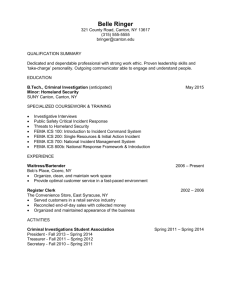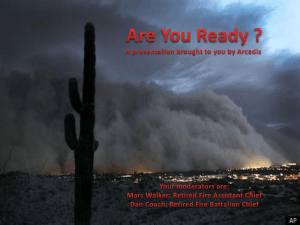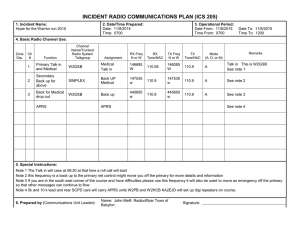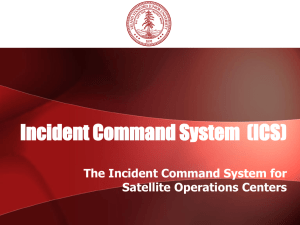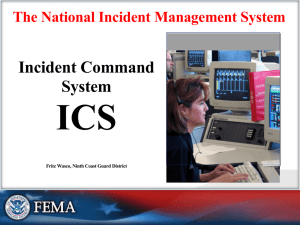Emergency Management for the Small GIS Shop
advertisement
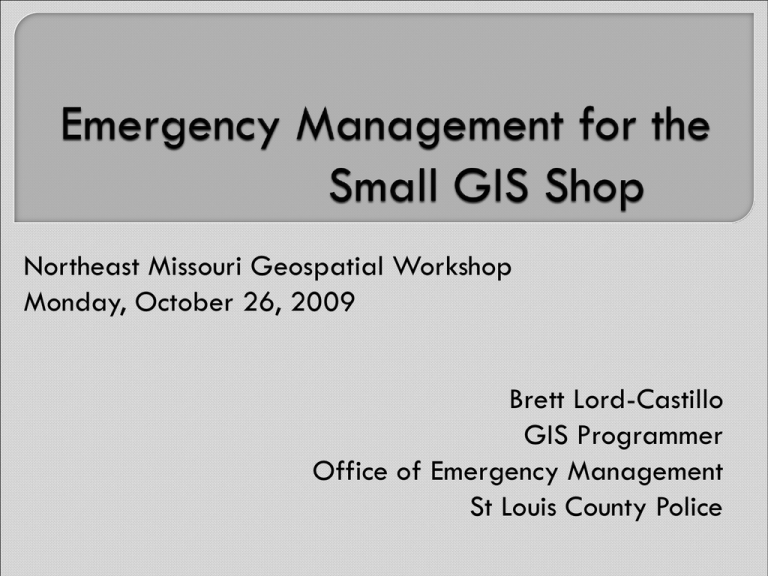
Northeast Missouri Geospatial Workshop Monday, October 26, 2009 Brett Lord-Castillo GIS Programmer Office of Emergency Management St Louis County Police All that you need and exactly what you don’t have Preparedness Planning Response Recovery Fundamental Concept: Geographic Information Systems is critical to all phases of Emergency Management http://training.fema.gov • Online Independent Study ICS-100/IS-100 Intro to Incident Command System ICS-200/IS-200 Basic ICS ICS-700/IS-700 National Incident Management System ICS-800/IS-800 National Response Framework IS-704 NIMS Communications and Information Management • Emergency Management Institute (“Free”) HAZUS Courses ICS-300/G300 Intermediate ICS (For Incident Support Team) ICS-400/G400 Advanced ICS (For Incident Support Team) Your EM agency • Which department is EM based in? • Who is your EM director? Part time or Full time? Home department? • How is it funded? (Especially Emergency Management Performance Grant) What are they? Which does your county have? Where do you fit in? • Fit yourself in if you have to Annex: Inside your department ESF #5: Emergency Management function (IS-805) • Create responsibilities (You’ll need the help) Preparedness Planning Response Recovery Timescale: Years Time period: Ongoing from end of activation Or After everyone goes home until you retire Participate! How were you successful? What problems did you encounter? How did you solve them? (Or what prevented you from solving them?) What was missing? Not “who dropped the ball” Address all four phases! http://www.llis.dhs.gov Hardest part of Emergency Management • Everyone wants to go home • Time critical - FEMA sets the timeline Not your job to assess damage • Your job is information (and some answers) Buildings to inspect Routes for inspectors Population affected? Where was the damage? Time scale: Hours to Days Time period: Declared Activation Or Everyone gets worried until everyone gets tired Incident Support Team GISCorps International Charter Your Neighbors! Local Businesses! Digital maps whenever possible • Web mapping if you can (Google Maps) • PDFs • GIS Software (if you have the time/people) • (Keep control of your software, especially when the news is there) Why? • Paper maps take time and supplies • Paper maps answer one question at a time Exception: Paper maps for operations • Information, not planning • People in the field (Find a laminator!) Impact Zone – Why? • Position resources (Emergency Response) • Search and Rescue (First Responders) • Protection (Public Safety) • Cleanup (Public Works) Considering using National Grid (but everyone needs to know how to use it) Impacted Infrastructure • Closed Roads • Damaged Buildings • Utilities (they want information from you too) • Press Release information (Parcels) Property Value Impacted People Your job as an analyst Integrated with rest of ICS briefing Time to shine (and get support later) Invite affected private groups Time Scale: Ongoing Time period: Beginning of threat until end of activation Or From the end of the last incident to the end of the next incident Manage your hours! • When are the operational hours? • Who handles map requests and when? • Have time for briefings • Mornings will be busy on multiday activations Manage your assets • Software (ask for help from your vendors) • Hardware (ask for help from everyone) • Printers (ask for help from anyone) • Consolidate and collect instead of maintaining Base data and base map • Streets, Parcels, Buildings, Railroads, Demographics Special Populations – MSDIS! • Hospitals, Nursing Homes, Schools*, & Daycares Tier II EHS • You have an inventory, geocode it Pipelines • National Pipeline Inventory Plume modeling of Tier II EHS Sites: ALOHA Points of Distribution Government Assets Industries/Private Assets Why are these so difficult? Parks Churches Non-governmental organizations Don’t forget animals! Pay attention to your hazard zones • Flood plains, EHS Sites, Earthquake liquefaction zones, Frequent fire, Tsunami, Locusts, Plague, Kindergartners… Where are they? FEMA USGS Consortiums Local knowledge! Communicate with the DFIRM engineering firms! Remember! Emergency management planning only! Sandbags are “cheap” Sandbag cleanup is expensive “Out source” analysis and image processing Vendor disaster plan (who sends the request, who takes the request) Mutual aid agreements! Time scale: Now! Time period: Yesterday Know your neighbors Get involved in ESFs or Annexes Train other staff on basic GIS software operations (move the map and print) Annual table top exercises Help your neighbors Incident Support Team • GIS skills in high demand • Training required! http://training.fema.gov ICS-100/IS-100 Intro to Incident Command System ICS-200/IS-200 Basic ICS ICS-300/G300 Intermediate ICS (For Incident Support Team)* ICS-400/G400 Advanced ICS (For Incident Support Team)* ICS-700/IS-700 National Incident Management System ICS-800/IS-800 National Response Framework *EMI Only Courses! (But GIS is in high demand) Funding opportunities • State training • EMI • Regional grants Remember: Your planning hours can count towards Emergency Management Performance Grant planning hours What next? • HAZUS-MH • Web Mapping (Open source stack) • Floodplain management • Digital image processing • Your specific hazards (table tops and hands on)
